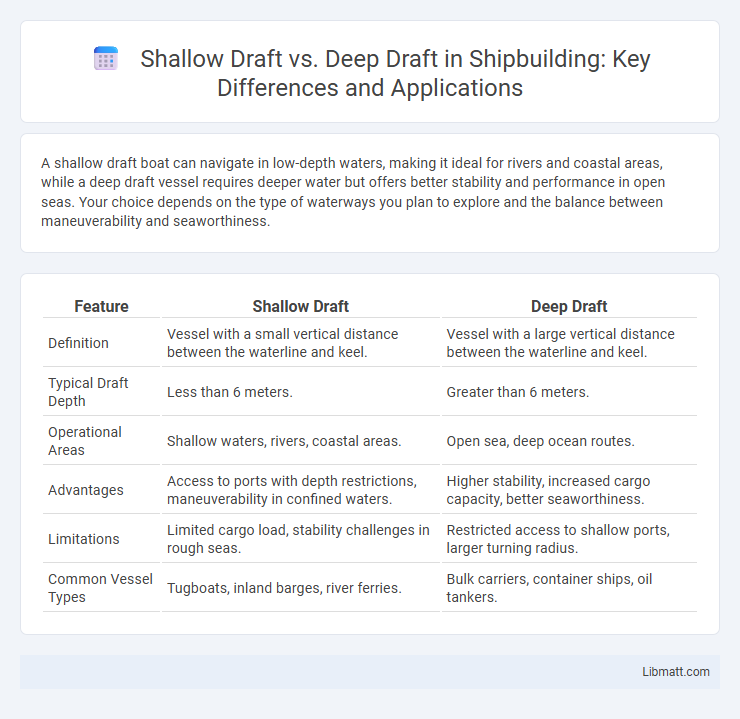A shallow draft boat can navigate in low-depth waters, making it ideal for rivers and coastal areas, while a deep draft vessel requires deeper water but offers better stability and performance in open seas. Your choice depends on the type of waterways you plan to explore and the balance between maneuverability and seaworthiness.
Table of Comparison
| Feature | Shallow Draft | Deep Draft |
|---|---|---|
| Definition | Vessel with a small vertical distance between the waterline and keel. | Vessel with a large vertical distance between the waterline and keel. |
| Typical Draft Depth | Less than 6 meters. | Greater than 6 meters. |
| Operational Areas | Shallow waters, rivers, coastal areas. | Open sea, deep ocean routes. |
| Advantages | Access to ports with depth restrictions, maneuverability in confined waters. | Higher stability, increased cargo capacity, better seaworthiness. |
| Limitations | Limited cargo load, stability challenges in rough seas. | Restricted access to shallow ports, larger turning radius. |
| Common Vessel Types | Tugboats, inland barges, river ferries. | Bulk carriers, container ships, oil tankers. |
Introduction to Vessel Drafts
Vessel drafts refer to the vertical distance between the waterline and the bottom of the hull, significantly impacting navigation and stability. Shallow draft vessels, typically measuring less than 5 feet, are ideal for navigating in waterways with limited depth, offering increased access to coastal areas and rivers. Deep draft vessels exceed 20 feet, providing enhanced stability and cargo capacity but requiring deeper ports and channels for safe operation.
Defining Shallow Draft and Deep Draft
Shallow draft refers to vessels with a minimal vertical distance between the waterline and the bottom of the hull, enabling navigation in shallow waters and coastal areas. Deep draft describes ships with a greater depth below the waterline, designed for enhanced stability and capacity in open oceans but limited to deeper ports and channels. Understanding the draft depth is crucial for optimizing vessel performance and ensuring safe operation in various maritime environments.
Design and Construction Differences
Shallow draft vessels feature a hull design with minimal underwater depth, allowing easier navigation in coastal and inland waters, while deep draft vessels have elongated hulls designed for stability and efficiency in open seas. Construction differences center on hull shape and weight distribution, where shallow draft boats prioritize flat or slightly curved bottoms to reduce draft, and deep draft vessels include deeper keels for better balance and structural integrity. Material selection and reinforcement vary to accommodate these designs, with deep draft ships often requiring stronger frameworks to withstand higher pressures and rougher sea conditions.
Operational Environments and Waterways
Shallow draft vessels operate efficiently in coastal waters, rivers, and estuaries with limited water depth, enabling navigation through narrow channels and shallow ports where deep draft ships cannot access. Deep draft vessels are designed for open ocean and deepwater harbors, offering superior stability and cargo capacity but requiring significant water depth and well-maintained shipping lanes. Operational environments dictate draft selection based on waterway depth, tidal constraints, and the nature of cargo transport demands.
Maneuverability and Handling
Shallow draft vessels offer superior maneuverability in confined or shallow waters due to their reduced underwater depth, allowing easier navigation in tight spaces and avoiding obstacles. Deep draft vessels, while providing enhanced stability and smoother handling in open waters, typically experience slower response times and require more careful planning during turns or docking. Your choice between shallow and deep draft directly impacts how agile and responsive your vessel will be in various marine environments.
Cargo Capacity and Load Implications
Shallow draft vessels, characterized by their reduced depth below the waterline, enable access to ports with limited depth but typically offer lower cargo capacity due to stability and hull design constraints. Deep draft vessels have increased cargo capacity, allowing them to carry heavier and bulkier loads, which optimizes economies of scale on long-haul shipping routes. However, their increased draft restricts them to deeper ports, influencing logistical planning and port selection based on load requirements.
Fuel Efficiency and Performance
Shallow draft vessels typically offer enhanced fuel efficiency in coastal waters and shallow regions due to reduced hull resistance, enabling smoother navigation and lower fuel consumption. Deep draft ships provide superior stability and performance in open seas, allowing for higher speeds and better handling under heavy load conditions, but often at the expense of increased fuel usage. Optimizing draft depth according to operational environment can significantly influence overall vessel efficiency and performance metrics.
Safety and Navigational Considerations
Shallow draft vessels offer enhanced safety in coastal and inland waters by reducing the risk of grounding in shallow or poorly charted areas, essential for navigating rivers and estuaries. Deep draft ships, designed for open ocean travel, provide greater stability in rough seas but require well-marked channels and deep ports to avoid underwater hazards. Mariners must balance draft depth with navigational charts, tides, and sediment conditions to ensure safe passage and prevent accidents.
Maintenance and Cost Factors
Shallow draft vessels typically incur lower maintenance costs due to reduced hull surface area submerged, which minimizes fouling and corrosion risks. Deep draft vessels require more extensive upkeep, including frequent hull inspections and increased anti-fouling treatments, leading to higher overall expenses. Your choice between shallow and deep draft should consider these cost implications alongside operational requirements to optimize budget efficiency.
Choosing the Right Draft for Specific Needs
Shallow draft boats are ideal for navigating shallow waters, rivers, and coastal areas with limited depth, providing better accessibility and maneuverability. Deep draft vessels offer superior stability and performance in open waters and rough seas, making them suitable for long-distance and heavy cargo transportation. Understanding your operating environment and specific requirements ensures you select the right draft, optimizing safety and efficiency for your boating needs.
Shallow draft vs deep draft Infographic

 libmatt.com
libmatt.com